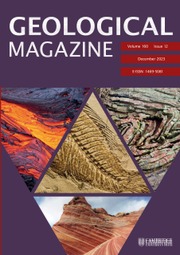Crossref Citations
This article has been cited by the following publications. This list is generated based on data provided by
Crossref.
Pe-Piper, Georgia
and
Piper, David JW
1998.
Geochemical evolution of Devonian-Carboniferous igneous rocks of the Magdalen basin, Eastern Canada: Pb- and Nd-isotope evidence for mantle and lower crustal sources.
Canadian Journal of Earth Sciences,
Vol. 35,
Issue. 3,
p.
201.
Améglio, L.
and
Vigneresse, J. L.
1999.
Geophysical imaging of the shape of granitic intrusions at depth: a review.
Geological Society, London, Special Publications,
Vol. 168,
Issue. 1,
p.
39.
Dessureau, Gilles
Piper, David J.W
and
Pe-Piper, Georgia
2000.
Geochemical evolution of earliest Carboniferous continental tholeiitic basalts along a crustal-scale shear zone, southwestern Maritimes basin, eastern Canada1Geological Survey of Canada contribution, 1999035.1.
Lithos,
Vol. 50,
Issue. 1-3,
p.
27.
Piper, David JW
and
Pe-Piper, Georgia
2001.
Tectonic deformation and magmatism along the southern flank of the Maritimes Basin: the northeastern Cobequid Highlands, Nova Scotia.
Canadian Journal of Earth Sciences,
Vol. 38,
Issue. 1,
p.
43.
Dunning, Greg R
Barr, Sandra M
Giles, Peter S
McGregor, D Colin
Pe-Piper, Georgia
and
Piper, David JW
2002.
Chronology of Devonian to early Carboniferous rifting and igneous activity in southern Magdalen Basin based on U-Pb (zircon) dating.
Canadian Journal of Earth Sciences,
Vol. 39,
Issue. 8,
p.
1219.
Koukouvelas, Ioannis
Pe-Piper, Georgia
and
Piper, David J.W
2002.
The role of dextral transpressional faulting in the evolution of an early Carboniferous mafic–felsic plutonic and volcanic complex: Cobequid Highlands, Nova Scotia, Canada.
Tectonophysics,
Vol. 348,
Issue. 4,
p.
219.
Pe-Piper, Georgia
Reynolds, Peter H
Nearing, Joe
and
Piper, David JW
2004.
Early Carboniferous deformation and mineralization in the Cobequid shear zone, Nova Scotia: an 40Ar/39Ar geochronology study.
Canadian Journal of Earth Sciences,
Vol. 41,
Issue. 12,
p.
1425.
Musumeci, G.
Mazzarini, F.
Corti, G.
Barsella, M.
and
Montanari, D.
2005.
Magma emplacement in a thrust ramp anticline: The Gavorrano Granite (northern Apennines, Italy).
Tectonics,
Vol. 24,
Issue. 6,
Koukouvelas, Ioannis K.
Pe-Piper, Georgia
and
Piper, David J. W.
2006.
The relationship between length and width of plutons within the crustal-scale Cobequid Shear Zone, northern Appalachians, Canada.
International Journal of Earth Sciences,
Vol. 95,
Issue. 6,
p.
963.
Burchardt, Steffi
Tanner, David C.
and
Krumbholz, Michael
2010.
Mode of emplacement of the Slaufrudalur Pluton, Southeast Iceland inferred from three-dimensional GPS mapping and model building.
Tectonophysics,
Vol. 480,
Issue. 1-4,
p.
232.
ERKÜL, FUAT
2010.
Tectonic significance of synextensional ductile shear zones within the Early Miocene Alaçamdağ granites, northwestern Turkey.
Geological Magazine,
Vol. 147,
Issue. 4,
p.
611.
Murphy, J. Brendan
Waldron, John W.F.
Kontak, Daniel J.
Pe-Piper, Georgia
and
Piper, David J.W.
2011.
Minas Fault Zone: Late Paleozoic history of an intra-continental orogenic transform fault in the Canadian Appalachians.
Journal of Structural Geology,
Vol. 33,
Issue. 3,
p.
312.
Park, Adrian F.
Treat, Robert L.
Barr, Sandra M.
White, Chris E.
Miller, Brent V.
Reynolds, Peter H.
Hamilton, Michael A.
and
Hibbard, Jim
2014.
Structural setting and age of the Partridge Island block, southern New Brunswick, Canada: a link to the Cobequid Highlands of northern mainland Nova Scotia.
Canadian Journal of Earth Sciences,
Vol. 51,
Issue. 1,
p.
1.
Waldron, John W. F.
Barr, Sandra M.
Park, Adrian F.
White, Chris E.
and
Hibbard, James
2015.
Late Paleozoic strike-slip faults in Maritime Canada and their role in the reconfiguration of the northern Appalachian orogen.
Tectonics,
Vol. 34,
Issue. 8,
p.
1661.
Pe-Piper, Georgia
Piper, David J.W.
Papoutsa, Angeliki
and
Wisen, Joshua
2017.
Fractured latest Devonian granites of the West Moose River pluton along the Cobequid Shear Zone, Nova Scotia: implications for regional mineralization.
Canadian Journal of Earth Sciences,
Vol. 54,
Issue. 11,
p.
1119.
Pe-Piper, Georgia
Piper, David J.W.
and
Papoutsa, Angeliki
2018.
Mid Carboniferous lamprophyres, Cobequid Fault Zone, eastern Canada, linked to sodic granites, voluminous gabbro, and albitization.
Lithos,
Vol. 296-299,
Issue. ,
p.
316.
Pe-Piper, Georgia
Piper, David J.W.
McFarlane, Chris R.M.
Sangster, Chris
Zhang, Yuanyuan
and
Boucher, Brandon
2018.
Petrology, chronology and sequence of vein systems: Systematic magmatic and hydrothermal history of a major intracontinental shear zone, Canadian Appalachians.
Lithos,
Vol. 304-307,
Issue. ,
p.
298.
Piper, David J. W.
and
Pe-Piper, Georgia
2021.
Evolution of late Paleozoic shearing in the Cobequid Highlands: constraints on the fragmentation of the Appalachian Orogen in Nova Scotia along intra-continental shear zones.
Geological Society, London, Special Publications,
Vol. 503,
Issue. 1,
p.
423.
Pe-Piper, Georgia
and
Piper, David
2021.
Controls on Barite Mineralization in a Major Intracontinental Shear Zone: Carboniferous of the Cobequid Highlands, Nova Scotia.
Minerals,
Vol. 11,
Issue. 12,
p.
1413.
Brooks, Kate I.
McCausland, Phil J.A.
and
Waldron, John W.F.
2021.
Paleolatitude and tectonic rotations of the Early Carboniferous Fountain Lake Group, Cobequid Highlands, Nova Scotia, Canada.
Canadian Journal of Earth Sciences,
Vol. 58,
Issue. 10,
p.
1103.

